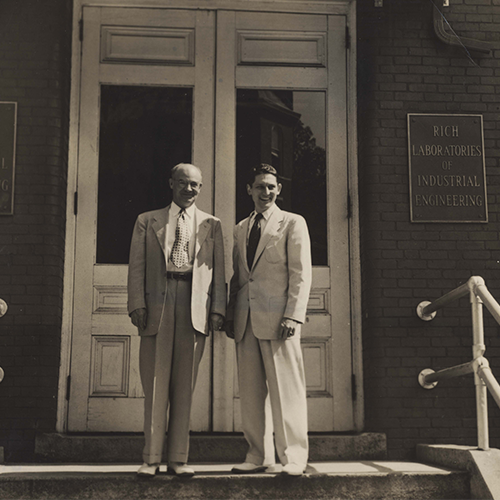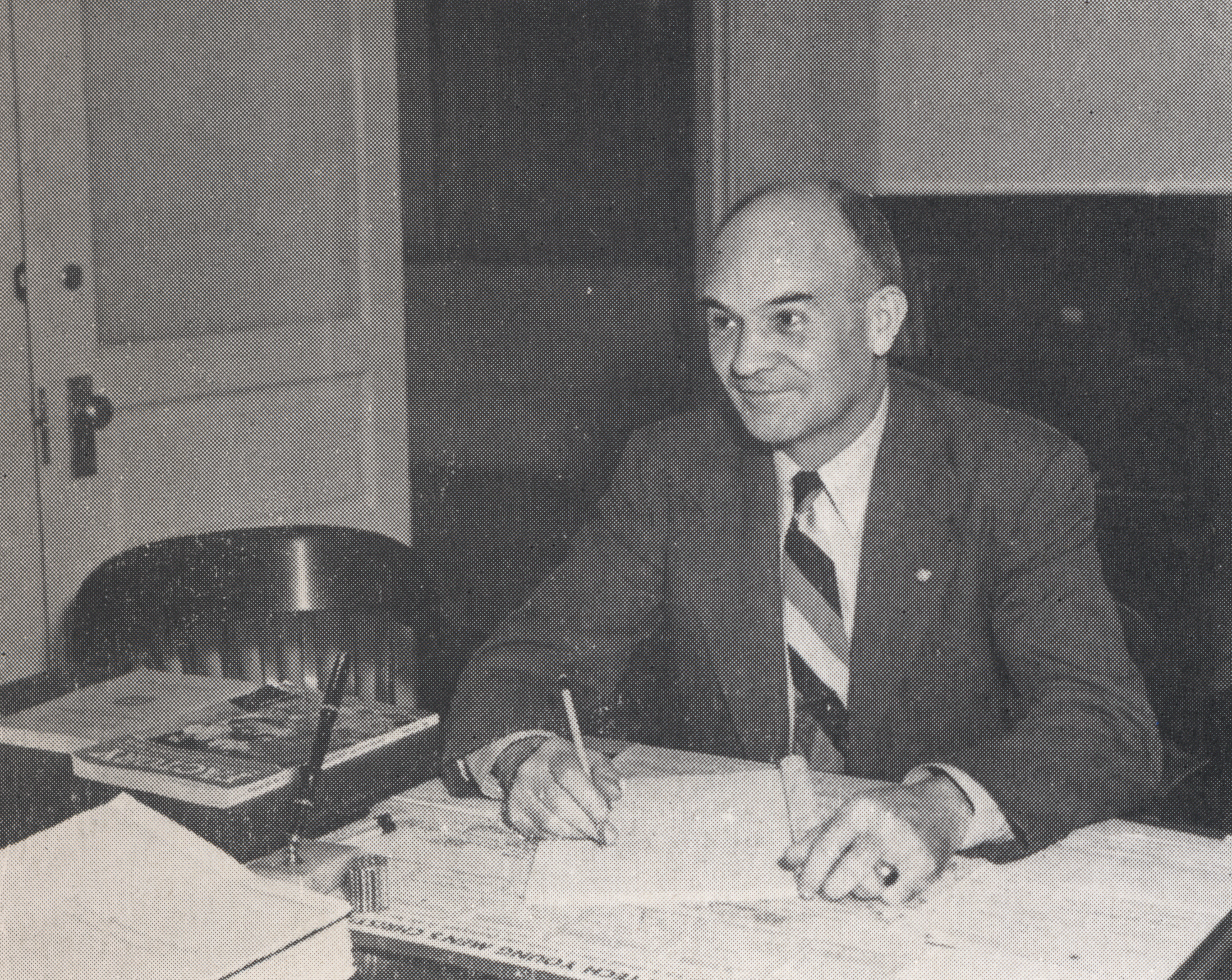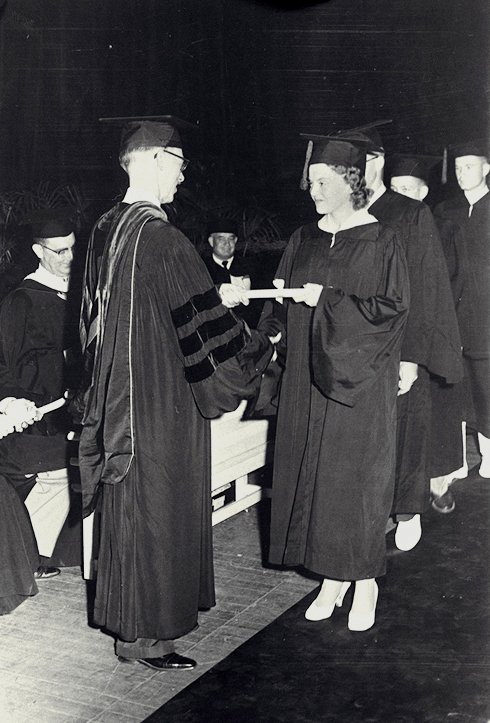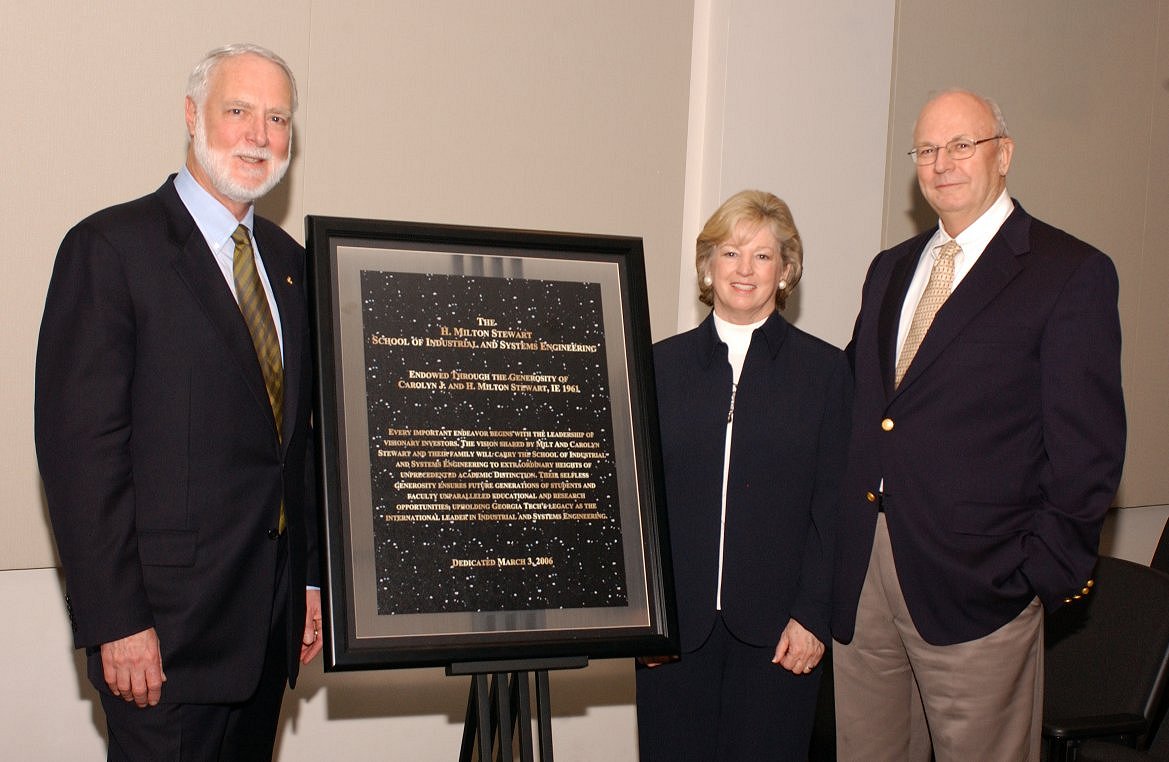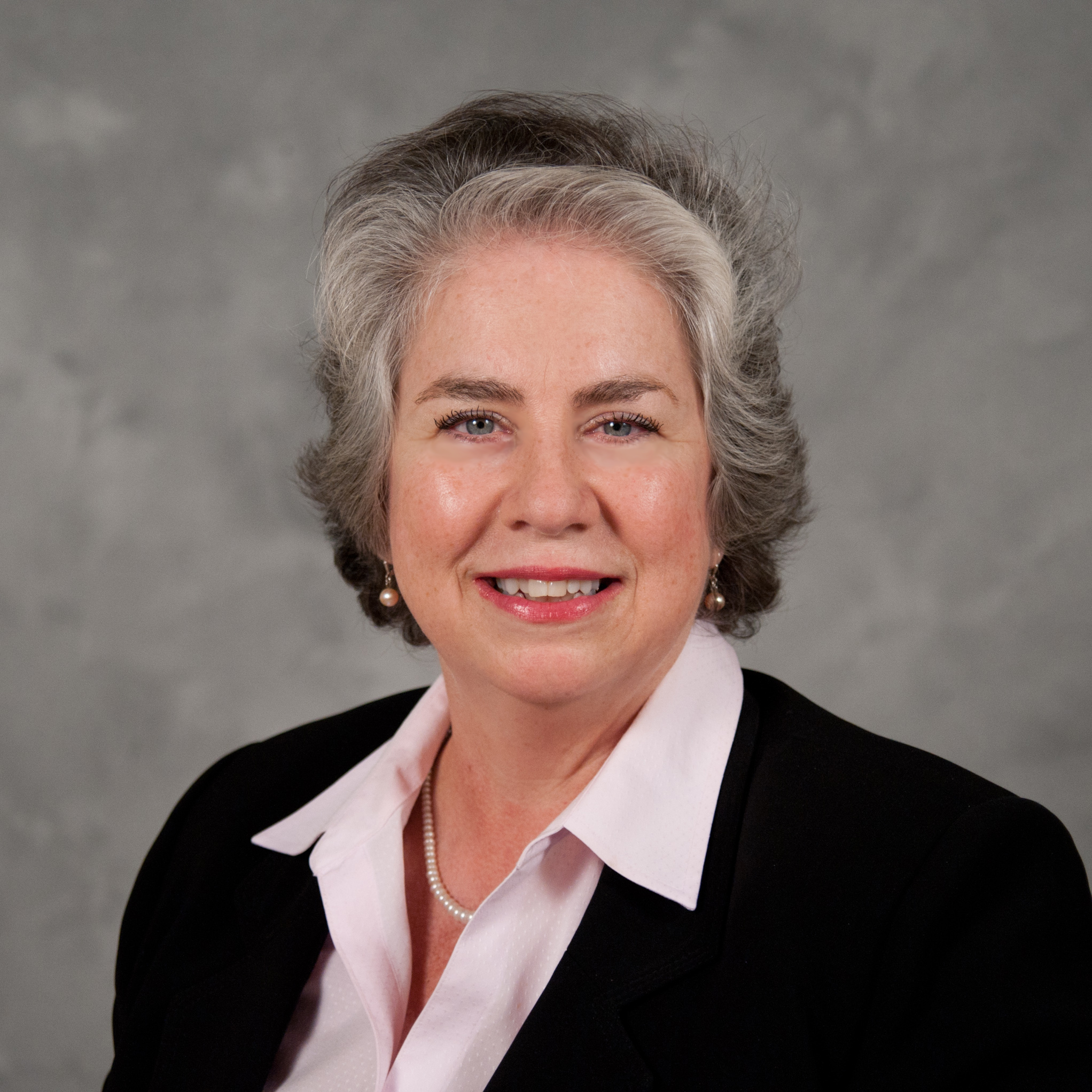For decades, ISyE has been the largest industrial engineering program in the world, with its undergraduate and graduate programs ranked No. 1 in the U.S. for 26 and 30 years, respectively. ISyE’s rise to the top parallels Georgia Tech’s own ascent to become one of the nation’s top public institutions, with the largest and most diverse college of engineering in the country.
The Institute began as the Georgia School of Technology in 1888 with 84 students enrolled in the only major offered: mechanical engineering. An “industrial option” was added to the curriculum in 1924.
In 1945, the Department of Industrial Engineering was created, and Colonel Frank Groseclose — known as the “father of industrial engineering” at Georgia Tech — served as the department’s first director and professor. Fifteen students — all white men — took Tech’s first official industrial engineering (IE) class. In 1947 a master’s program was created, and the department was elevated to the School of Industrial Engineering in 1948.
In 1952, Georgia Tech opened its doors to female students, and Elizabeth Herndon and Diane Michel — both IE majors — were the first two women to enroll. Four years later, Michel became the first woman to complete her degree from start to finish at the Institute and graduate.
Georgia Tech was also one of the few universities in the South to desegregate without a court order, and in 1961 the first Black students enrolled. The first Black industrial engineer, William Johnson, graduated in 1970.
A Strong Foundation
Georgia Tech’s School of Industrial Engineering quickly grew in prominence. Although there were no national rankings during Groseclose’s time, Tech’s undergraduate program was recognized as one of the best. “The industrial engineering program under the Colonel was a place where there were high expectations. That was true for all Georgia Tech,” recalled ISyE Professor Emeritus Leon McGinnis in the 2005 issue of Engineering Enterprise.
When Groseclose left the School in 1965, Professor Robert Lehrer, who had previously served as associate director and helped establish the graduate program, assumed the role of school chair and began to modernize the curriculum to reflect IE applications that expanded beyond a factory setting. In 1969, the word “systems” was added to the School’s official name to further reflect this.
At the same time, the Institute’s reputation was growing. When Joseph Pettit became president of Georgia Tech in 1972, he began a campaign to elevate Georgia Tech to a top-tier research institution with an emphasis on doctoral education. To help execute Pettit’s vision, Lehrer hired mathematically and quantitatively oriented faculty members, many of whom had research backgrounds, while continuing to deliver quality education to students.
During this time, Georgia Tech and ISyE saw another first: Augustine Esogbue, an expert in fuzzy sets and neural networks, arrived at the Institute and became the first Black faculty member to receive tenure and be promoted to full professor.
In 1978, Michael Thomas, who had previously chaired the IE department at the University of Florida, followed Lehrer and became ISyE’s third school chair. To enhance ISyE’s research portfolio, Thomas continued to recruit key faculty in both traditional IE and operations research (OR) fields from well-respected research institutions. Many of these hires became leaders in their fields and spent the majority of their careers at ISyE.
To assist in hiring top research faculty for the Institute, Tech began its first capital campaign to create an endowment that would support research opportunities. In 1985, A. Russell Chandler III (BIE 1967) — a successful IE alumnus — funded the A. Russell Chandler III Chair in ISyE, the first endowed chair for both ISyE and Georgia Tech. Thomas recruited renowned operations research expert George Nemhauser as the first faculty member to come to Tech as part of the capital campaign. Just a year later, Nemhauser was the first sitting faculty member at Georgia Tech elected to the National Academy of Engineering (NAE), one of the highest distinctions accorded an engineer. Nemhauser, who continues to be a world leader in his field, still holds his endowed chair at ISyE 35 years later.
According to ISyE Professor Emeritus R. Gary Parker, who served as a faculty member from 1972 until his retirement in 2011, Thomas “created a culture that valued deep and fundamental research and its application in important practical domains. Theoreticians were respected, as were real-world problem-solvers. That got noticed and began to further set the School apart.”
Increasing the size and quality of the School’s graduate program was necessary to support the Institute’s expanded research focus. Nemhauser, along with a core of like-minded faculty, revamped ISyE’s doctoral curriculum and recruiting strategy, making it one of the best in its class. In addition to the robust curriculum, the unmatched quality of ISyE’s faculty helped attract top Ph.D. students, which further strengthened the program.
“Mike was able to pursue and achieve excellence by identifying and hiring faculty, both young and senior, who were among the best in the field,” said Nemhauser. “He changed ISyE at the graduate/research level from pedestrian to among the top to the very top. While now all engineering schools at Tech are in the top 10, ISyE led the way.”
In 1989, Thomas left his position at ISyE to serve Georgia Tech at the Institute level, and Professor John Jarvis stepped into the role of school chair.
ISyE Becomes No. 1
The graduate program continued to grow in size and quality, propelling it in 1990 to become the No. 1 graduate program of its kind as ranked by U.S. News & World Report. Five years later, the undergraduate program was also ranked No. 1 for the first time. Both programs have maintained their top rankings ever since.
Jarvis continued to seek out the best students and faculty, and pursued funding opportunities to support both. During Jarvis’ tenure as school chair, 1989-2001, the School raised more than $25 million as part of The Campaign for Georgia Tech. This generous support from prominent alumni was an instrumental component in ISyE’s continued success by funding additional professorships and chairs, cutting-edge programs, fellowships, and scholarships.
In addition to Chandler, H. Milton Stewart Jr. (IE 1961) and his wife Carolyn (Honorary Alumna 2008) have been two of the school’s biggest supporters. In 1999, the Stewarts endowed the H. Milton and Carolyn J. Stewart School Chair in ISyE, which allowed the school to attract leaders that would continue its momentum. It was also the first endowed school chair position at Georgia Tech, and was initially held by Jarvis; he stepped down in 2001 after 12 years in the role. The school chairs that succeeded Jarvis have continued the school’s upward trajectory. They included William Rouse (2001-04); Chelsea “Chip” White III (2005-10); Jane Ammons (2011-14), ISyE’s first female Ph.D. graduate in 1982 and the first female school chair in the College of Engineering; and current H. Milton and Carolyn J. Stewart School Chair Edwin Romeijn (2015-present).
“Quality attracts quality,” noted Parker. “The school chairs have understood what keeps ISyE at No. 1. They continue to attract top faculty who understand our science and respect the relevance of its application and work hard to attract top doctoral students — the ones a first-rate faculty demands.”
In 2006, the Stewart family made an even bigger contribution and endowed the School as the H. Milton Stewart School of Industrial and Systems Engineering.
Continuing Success
ISyE’s unmatched size allows for strong groups in both traditional IE research and in new interdisciplinary research initiatives such as analytics and machine learning; energy and sustainable systems; and health and humanitarian systems. This breadth provides both students and faculty with a unique, rich environment in which to conduct cutting-edge research.
Similarly, the Institute is now one of the leading research universities in the U.S. with more than 25,000 undergraduate and graduate students, six colleges, and 28 schools. Its College of Engineering is ranked No. 4 in U.S. News & World Report’s Best Undergraduate Engineering Programs, and all its graduate programs are ranked in the top 10.
In February 2020, Georgia Tech received approval from the University System of Georgia and the Board of Regents to move forward with construction plans for ISyE’s new home in Technology Square. George Tower, named in honor of longtime ISyE supporters William “Bill” (BIE 1964, Honorary Ph.D. 2008) and Penny George, will provide ISyE students, faculty, and staff with a newly designed space for research and instruction. George Tower will bring ISyE into the vibrant ecosystem of Tech Square along with innovative startups, the global headquarters for many businesses, and the Scheller College of Business.
“Our rise to the top was the result of the hard work and dedication of the School’s faculty and alumni throughout the years who were able to execute their vision for what Georgia Tech and ISyE could become,” said H. Milton and Carolyn J. Stewart Chair Edwin Romeijn. “We are working hard to continue this legacy of excellence and provide our community with the resources necessary to stay at the top of our field.”
The program that began with just 15 students now has more than 1,300 undergraduate and 4,000 graduate students, and one in 10 graduates will rise to the top position in his or her organization. What exactly the future holds for ISyE is unknown, but one thing is certain — the School will continue to lead the way.
For More Information Contact
Laurie Haigh Communications Manager
